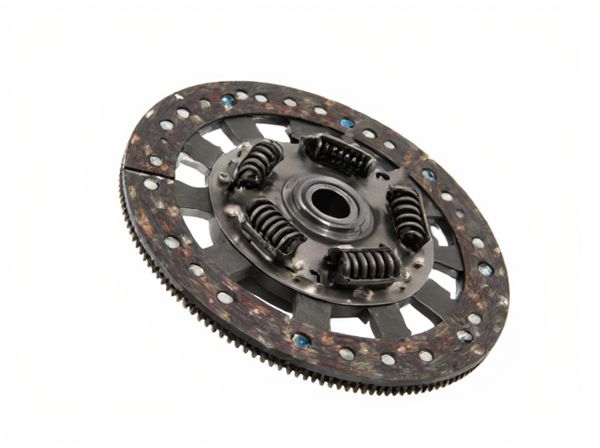
Photo illustration: Centrifugal Clutch vs Electromagnetic Clutch
A centrifugal clutch engages automatically based on engine speed by using centrifugal force to connect the drive shaft, making it ideal for applications without manual control. An electromagnetic clutch, on the other hand, operates using an electrical current to create a magnetic field that engages or disengages the clutch, offering precise and instant control. Your choice depends on whether you prioritize simplicity and automatic engagement or require adjustable, on-demand clutch operation.
Table of Comparison
| Feature | Centrifugal Clutch | Electromagnetic Clutch |
|---|---|---|
| Operation | Engages automatically based on engine speed (centrifugal force) | Engages via electric current to magnetic field |
| Control | Speed-dependent, no manual control | Electrically controlled, precise engagement |
| Response Time | Moderate, depends on RPM | Fast, nearly instantaneous |
| Wear and Maintenance | Higher wear due to friction engagement | Less mechanical wear, requires electrical maintenance |
| Applications | Small vehicles, go-karts, lawnmowers | Automotive transmissions, industrial machines |
| Cost | Lower initial cost | Higher cost due to electrical components |
| Efficiency | Less efficient at variable speeds | High efficiency with precise control |
Introduction to Clutch Technologies
Centrifugal clutches engage automatically using centrifugal force as engine speed increases, providing smooth power transmission without manual input, commonly used in small engines and go-karts. Electromagnetic clutches operate by using an electromagnetic field to engage or disengage the clutch, allowing precise control and rapid response, often found in industrial machinery and automotive applications. Both technologies optimize power transfer but differ significantly in control mechanisms and application suitability.
How Centrifugal Clutches Work
Centrifugal clutches engage automatically based on engine speed by using centrifugal force to move weighted shoes outward, pressing against the clutch drum and transmitting power. As the engine RPM increases, the force overcomes spring tension, causing the shoes to expand and connect the input shaft to the output shaft. This self-regulating mechanism eliminates manual clutch control, making centrifugal clutches ideal for small engines and machinery with variable speeds.
Principles of Electromagnetic Clutches
Electromagnetic clutches operate on the principle of electromagnetism, where an electric current flows through a coil creating a magnetic field that engages the clutch plates, transferring torque without mechanical wear. This precise engagement allows for smooth transmission control and rapid response, making electromagnetic clutches ideal for applications requiring frequent start-stop cycles or variable speed control. Compared to centrifugal clutches, which rely on rotational speed and friction weights, electromagnetic clutches offer greater accuracy, reliability, and tunability in power transfer systems.
Key Differences Between Centrifugal and Electromagnetic Clutches
Centrifugal clutches engage automatically based on engine speed, using centrifugal force to connect the drive shaft without external power, making them ideal for simple, low-maintenance applications. Electromagnetic clutches rely on electric current to create a magnetic field that engages or disengages the clutch, allowing precise control and suitability for complex machinery needing variable torque transmission. The primary difference lies in activation method--mechanical speed-based engagement versus electrically controlled engagement--impacting response time, control precision, and application versatility.
Advantages of Centrifugal Clutches
Centrifugal clutches offer automatic engagement based on engine speed, eliminating the need for manual operation and reducing operator effort. Their robust, simple design provides reliable performance in harsh environments with minimal maintenance requirements. These clutches deliver smooth power transmission and protect the engine from overload by engaging only at predetermined RPM thresholds.
Benefits of Electromagnetic Clutches
Electromagnetic clutches offer precise and rapid engagement, enabling smooth power transmission and reducing wear compared to centrifugal clutches. These clutches provide greater control over torque transfer, enhancing performance in applications requiring variable speed and load conditions. Their ability to engage and disengage on demand improves energy efficiency and extends the lifespan of connected machinery.
Typical Applications for Centrifugal Clutches
Centrifugal clutches are commonly used in small engines, go-karts, mini bikes, and lawn equipment where automatic engagement and disengagement based on engine speed are essential. These clutches enable smooth power transmission without manual intervention, making them ideal for applications requiring variable speed control and low maintenance. In contrast, electromagnetic clutches are more suited for industrial machinery and automotive applications demanding precise, electrically controlled engagement.
Common Uses for Electromagnetic Clutches
Electromagnetic clutches are commonly used in automotive air conditioning systems, industrial machinery, and printing equipment due to their precise and rapid engagement capabilities. They enable smooth power transmission by electronically controlling the clutch activation, making them ideal for applications requiring frequent on/off cycling and reliable torque transfer. Unlike centrifugal clutches, electromagnetic clutches offer greater control and are preferred in systems where performance consistency and minimal wear are critical.
Maintenance and Durability Comparison
Centrifugal clutches require minimal maintenance due to their simple mechanical design, but the friction components wear out over time, necessitating periodic replacement to maintain performance. Electromagnetic clutches offer longer durability with fewer mechanical wear parts and allow for more precise control, though their maintenance involves electrical system checks and occasional coil or contact replacements. Overall, centrifugal clutches are cost-effective for low-maintenance needs, while electromagnetic clutches provide superior longevity and reliability in applications demanding frequent engagement and disengagement.
Choosing the Right Clutch for Your Needs
Selecting the right clutch depends on your application's power requirements and control precision; centrifugal clutches offer automatic engagement based on rotational speed, making them ideal for small engines and simple machinery with variable speeds. Electromagnetic clutches provide precise, on-demand engagement with electrical control, suited for industrial machines requiring quick response and exact torque application. Evaluating factors like load capacity, response time, and maintenance needs ensures optimal performance and longevity in your specific use case.
 caratoz.com
caratoz.com